

Should stamp collectors be concerned with forgeries or unofficial reprints which are not sanctioned by any postal body or recognized as authentic philatelic material? This depends on the readers collecting area an concern for throwing money at stamps with the belief that they are real, when in fact they are not (wasting money). This seems like a bold statement for one of the most popular hobbies in the world, whose audience includes young children to adults of all ages. However, the fact of the matter is, forgeries abound and are bought, sold and traded every day with the belief of being real. Forgeries are not limited to just expensive stamps but are found with common stamps just as prolifically as the expensive issues. This article will explain why its important to be cognizant of forgeries and should convince the reader that with little effort any collector can reduce the possibility of acquiring a stamp under false pretenses.
Most collectors do not worry about forgeries because they do not realize they
are out there, or believe that its too hard to detect forgeries and put
their trust 100% with the sellers' abilities.
One would think this philosophy should be fool
proof when buying and selling from reputable (or knowledgeable) dealers.
While this may reduce the probabilities, it still is not good enough. All
of the stamps pictured in this article were purchased from VERY reputable
dealers, who are very respected and knowledgeable in the craft. It is important
to understand, that while honest dealers try to catch all forgeries before
selling a stamp, it is just not feasible, and not a practical expectation for a
buyer to have. There are many reasons why the buyer should be concerned
when buying stamps from any dealer of seller:
Since dealing with reputable dealers will not protect a buyer from obtaining a forgery, it is clear that the buyer must take some responsibility for either avoiding the purchase of a forgery, or for detection at some point in time, so that one does not end up with a book of unwanted items. To aid the collector in forgery detection there are organizations which have services that certify whether a stamp is authentic or not. The APS (American Philatelic Society) offers such a service and has a very good reputation for being accurate. Such organizations have experts take a look at a stamp and render an opinion as to its authenticity. The opinions are not always right, so any opinion can be challenged, but more than not, they are correct. So why not send in all of your stamps? This would get too expensive, too quickly, as the minimum charge per stamp by the APS is $15 and the final cost is based on the value of the stamp. The more valuable the stamp, the more expensive the service. Stamps sent into for expertising should be ones believed to be authentic (possibly to aid in resale value) or are items the collector is unable to make a final determination one way or the other on. Expertising services only make sense for stamps of higher value and thus, are not practical for all stamps.
The best defense and most cost effective way of dealing with forgeries is to avoid purchasing them in the first place. Using services, like APS, should be a final safeguard. The examples provided below will show the reader just how easy it is, and will demonstrate that with very little effort and experience, a buyer can avoid the purchase of a bad stamp by the do-it-yourself method, thus saving lots of money by only purchasing genuine stamps. Collectors of inexpensive stamps may chose to not worry about forgeries as the potential cost, or loss, will be negligible, but it should be well noted that many inexpensive stamps, some valued less than .25c, have been forged in great numbers. In many cases, there are more forged copies than authentic copies in existence.
There are a number of good publications out on how to detect forgeries. These include books, pamphlets and journals. If you are interested in buying stamps from a certain region, then it would be in your best interest to find a book that specializes on stamps from that area. For the stamps used in this article the following books were used: "Distinguishing Characteristics of Classic Stamps" by Hermann Schloss and the GPS (German Philatelic Society) Reference Manuals on Forgeries. These kinds of books are available for checkout at various philatelic libraries (such as the APS and Western Philatelic Library). Since stamps are being forged all the time, new information is always coming out and periodic checks with a library is recommended. (NOTE: The quality and number of reference materials used in forgery detection will help the reader better detect forgeries. Some stamps are difficult, even for the very experienced, so the key to more advanced forgery detection is experience.)
The first example of how to detect a forgery will be done on Baden #7. Pictured
below is a good copy and a forgery. By visual inspection, can you determine
which one is the forgery? Many people will say that the stamp on the right
is the forgery because it looks sloppy, with bad details in the design. While
this is the forgery, this is not the reason. Many stamps look like this because
of the printing methods, worn plates or the design (engraving) was rough to
start with.
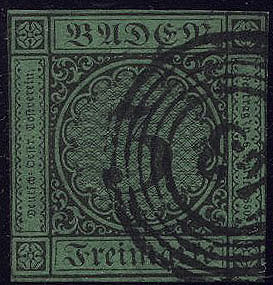
|
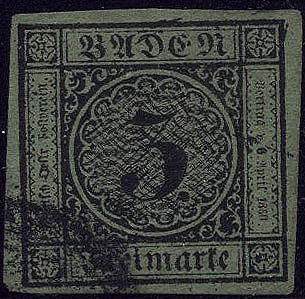
|
|
| pic. 1 | pic. 2 |

|
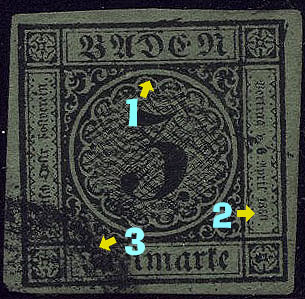
|
|
| pic. 3 | pic. 4 |
The current catalog value of a Baden #7 used is $6.50. This is not considered a valuable stamp by any means and thus, serves as a warning to collectors who scuff at the notion that only expensive stamps are forged. Also, this stamp shows that detecting a forgery is easy, once the collector knows what to look for. In many cases, detection is just a matter of knowing what line belongs and which does not.
Adhering to the belief that expensive stamps are heavily forged, we now look
at two mint stamps from an early German State which catalog $300 apiece.
However, one of these Bremen #5 is a forgery. Looking at pictures
#5 & #6 can you tell which one is authentic?

|
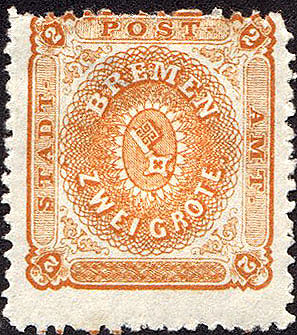
|
|
| pic. 5 | pic. 6 |
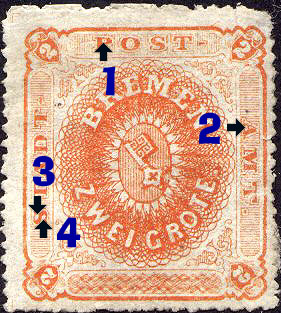
|
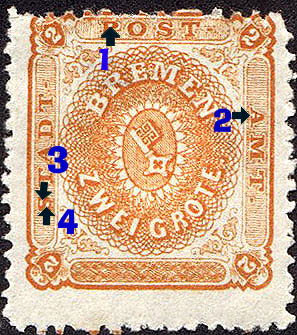
|
|
| pic. 7 | pic. 8 |

|

|

|
||
| pic. 7a | pic. 7b | pic. 7c |
There are some stamps worth more used than unused. Many of these stamps
typically have forged cancellations to make a mint stamp appear postally
used. When a forger decides to forge one of these stamps, it is usually
forged with a fake cancellation or is actually placed on an envelope and
is postally used to make the stamp appear valid.
A postally used forgery may have some value to some
collectors, but will normally never have close to the value of its authentic
counterpart, and to most collectors would be worthless.
The following example of Lubeck #4 (pictures #9 & #10) shows a mint copy
of the authentic stamp, which is valued at $19 and its forged counterpart,
with cancellation, valued at $575 if authentic. This example concentrates
on the stamp itself and not the cancellation.

|

|
|
| pic. 9 | pic. 10 |
Pictures #11 & #12 point out three items that are used to differentiate between
an authentic and forged copy of this stamp. There are many other indicators,
but these three should suffice in demonstrating that you would not want to
pay anything close to $575 for the stamp in picture #12.
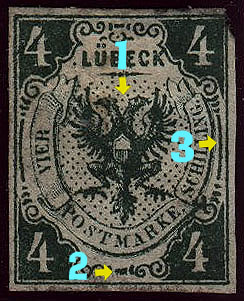
|
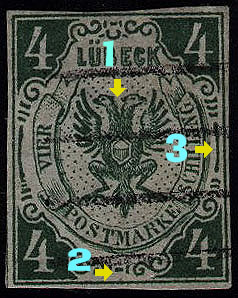
|
|
| pic. 11 | pic. 12 |
The numbered items should be interpreted as follows:
<0l>
All of the examples up to this point have compared a forged copy against an authentic copy. This is the preferred method (many dealers build up collections of both authentic and forged stamps to be used for forgery detection of new stamps acquired) as its very easy to see the differences. The following examples will look at a single copy of a stamp and the indicators used, to help determine authenticity versus forgery. It will be apparent when visually inspecting the items, that its harder in making the final determination, but is still straightforward, in these examples, for the novice to make the correct assessment.
The following two examples will use some very clean copies of stamps from
Bremen. Picture #13 represents Bremen #3 and picture #14 represents Bremen
#7.
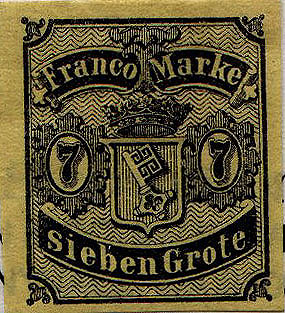
|
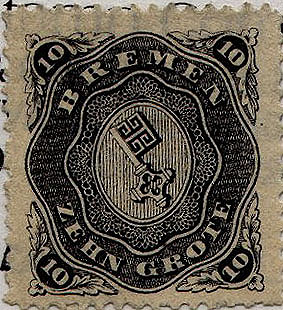
|
|
| pic. 13 | pic. 14 |
Both of these stamps are forgeries. Pictures #15 & #16 point out what was used
in determining them to be forgeries.

|
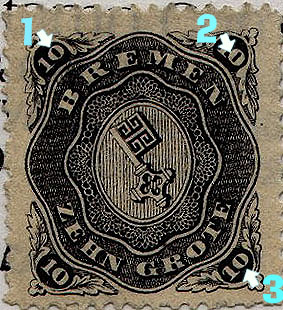
|
|
| pic. 15 | pic. 16 |
Bremen #3 fails the following checks:
Having an authentic copy of Bremen #3 would have made the first point crystal clear whether or not the b in this copy is legitimate or not. However, with a magnifying glass, it is quite clear to see that the b is closed. Using good judgment and a bit of confidence, one should come to the conclusion that this is a forged stamp.
Bremen #7 is difficult to determine authenticity, but with sound judgment, the following points clearly define this stamp as a forgery:
The differences between an authentic Bremen #7 and a forged Bremen #7 are slight, but quite easily detectable. With some simple knowledge, it is easy to tell the difference between two Bremen stamps which are valued at $650 and two forged stamps which are not worth much at all.
The examples so far have concentrated on detecting a forged stamp. The goal
of forgery detection is to find authentic stamps. The last example presented
will highlight the items used in determining that a stamp is authentic.
The stamp to be used is a Bergedorf #1, picture #17, which has been forged
many times over (GPS lists six different common forgeries of this issue).
Picture #18 highlights the main points used in differentiating this stamp
from its forged counterparts.
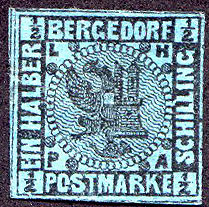
|
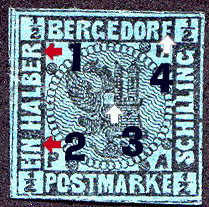
|
|
| pic. 17 | pic. 18 |
Having now gone through a number of examples, the reader should be convinced that all collectors should be aware of forgeries and that anyone can do basic forgery (authentication) detection. With simple research, and a good book, forgery detection is available to any collector who wishes to embark on this endeavor. It still must be pointed out that some forgeries are so good, that detection is best left up to experts in the field, and for those stamps, services like the "APS expertising", should be consulted. Failure to detect forgeries may leave a collection full of worthless stamps and great disappointment when a stamp is put up for sale or shown to another collector.